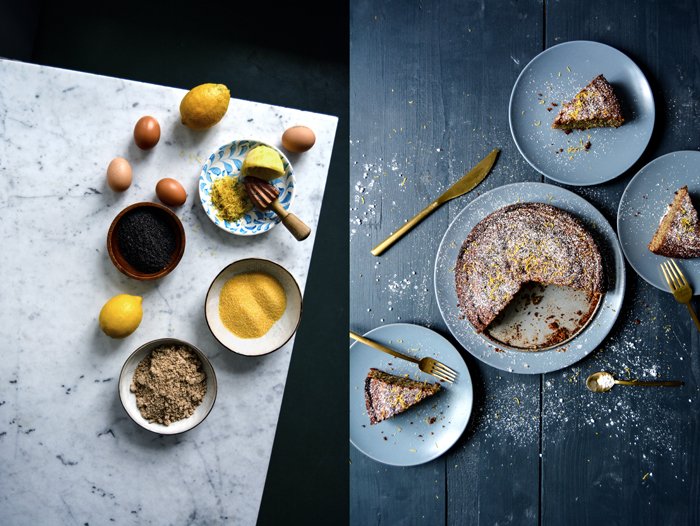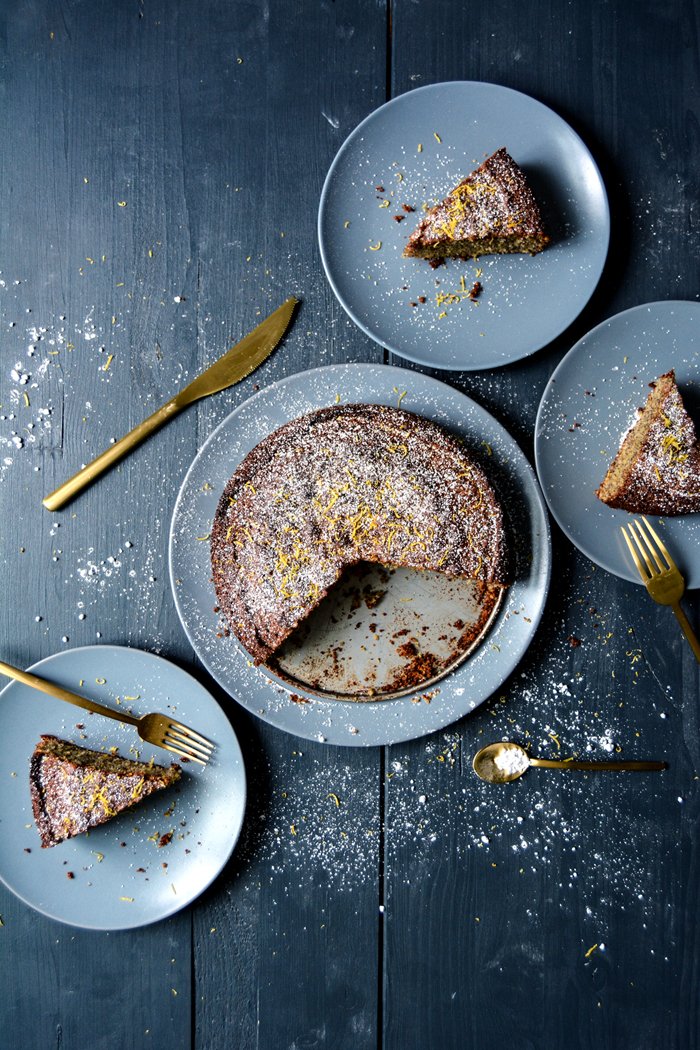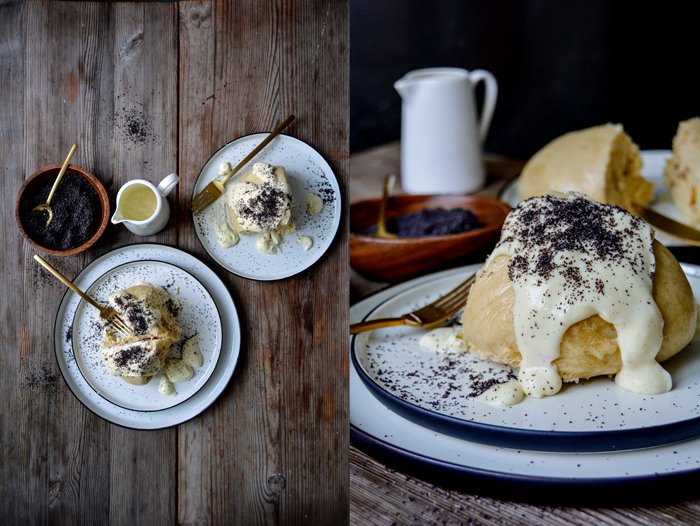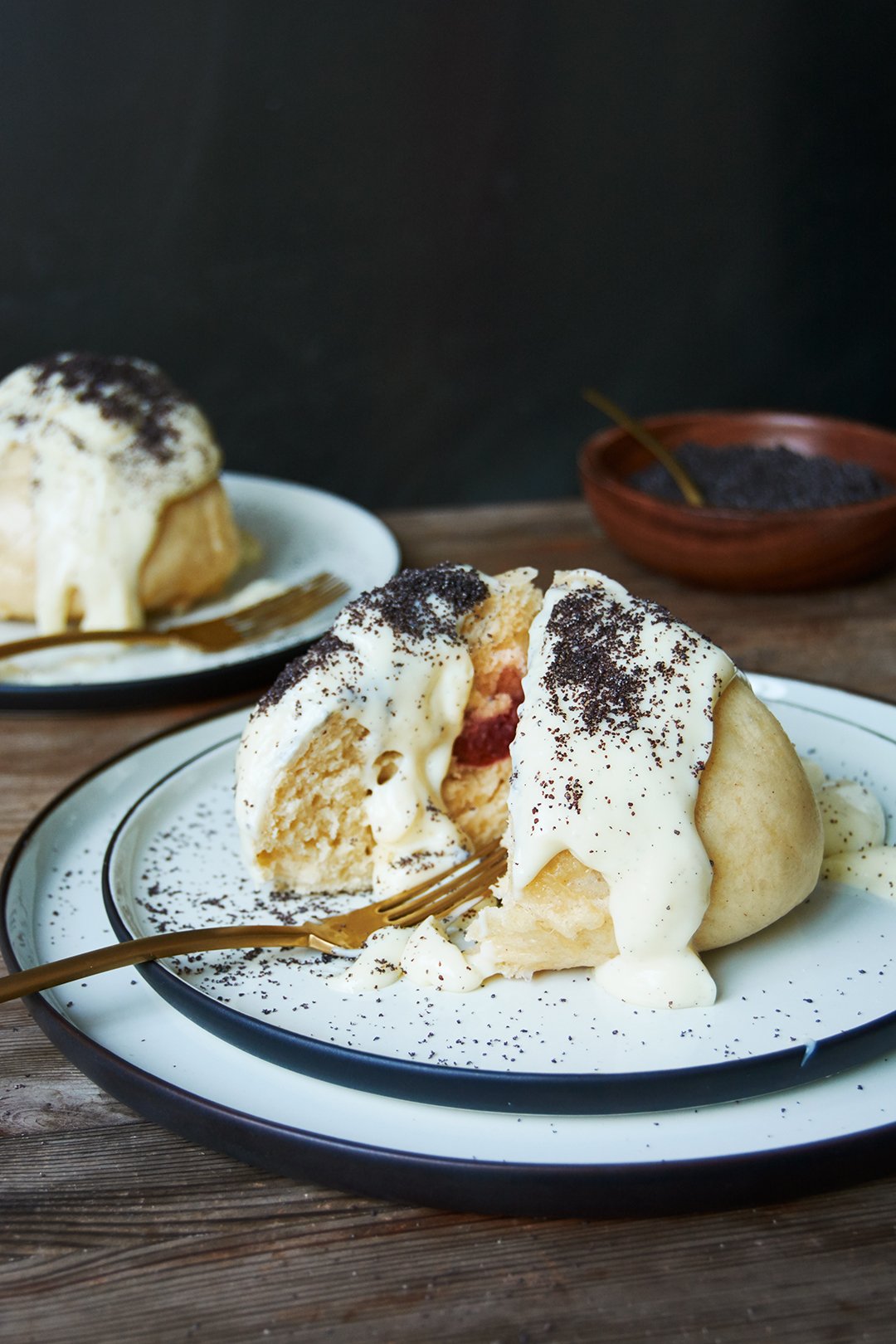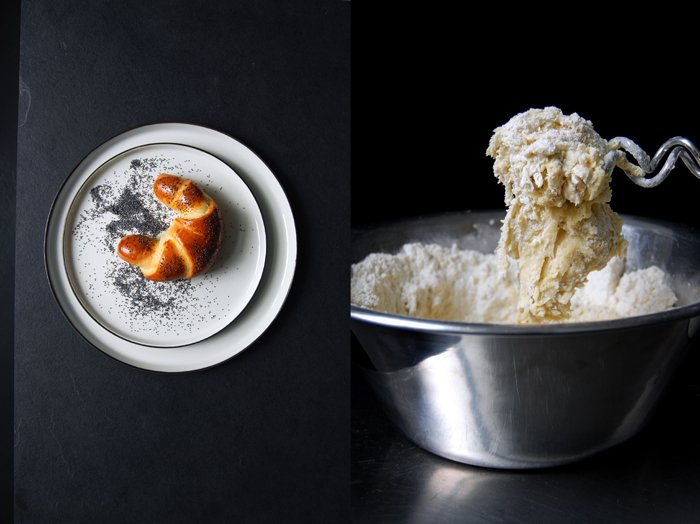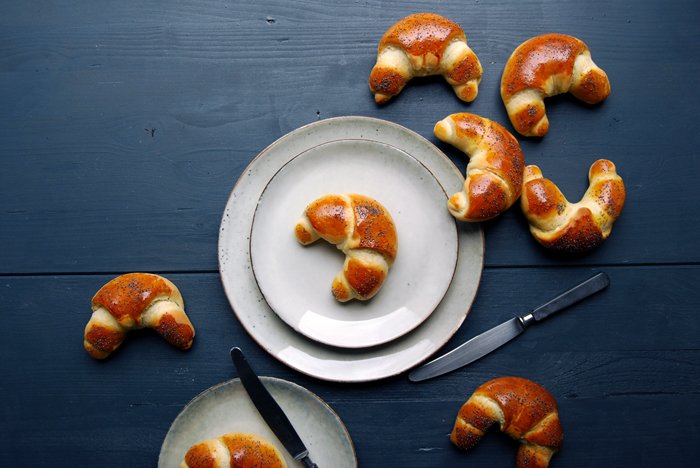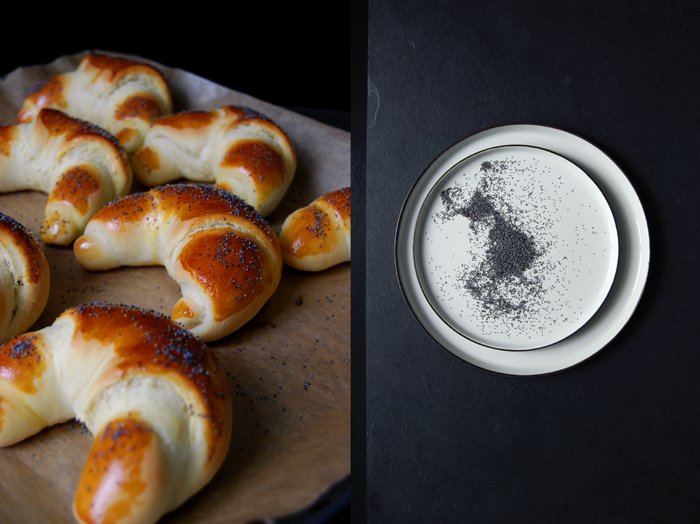Ricotta Polenta Almond Cake with Poppy Seeds and Lemon
No flour again! After my Spanish Almond Tart with Blood Orange, I got a little hooked on no-flour cakes. I don't follow a gluten-free diet - luckily, my diet is far from this - it's just for the fun of it. The texture is different when you work with ground nuts instead of wheat or spelt, it's more juicy, and here, the polenta adds some crunchiness. I've already experimented with a few polenta-almond combinations and enjoyed this one a lot: poppy seeds, ricotta, and lemon. I use ground poppy seeds, they don't look as pretty in the cake but they have a richer aroma than the whole seeds. The juice and zest from the citrus fruit makes it nice and fresh and helps me to forget that the variety of fruits that I can use for my baking projects is still quite limited. It's mainly citrus, apple, and pear but I'm coping. Only a few more months left and all those berries will be back in my kitchen.
This weekend, I'm spending some quality time with my mother. It's carnival and, according to our annual family tradition, we all meet in the countryside to make Berliner (jam filled German doughnuts). We dress up funny (some of us) and listen to silly music, it's actually so silly that it's better to drink some wine or Champagne while it's on to stand its distinct humour. Two years ago, I wrote about this family feast and shared the recipe for our sweet treat. If you're up for it - carnival isn't over yet - here's the recipe. And if you prefer the Greek version, here are my Loukoumades with Honey, Cinnamon, and Pistachios.
Ricotta Polenta Almond Cake with Poppy Seeds and Lemon
Makes 1 cake
ground skin-on almonds 150g / 5 1/2 ounces
fine polenta 80g / 3 ounces
baking powder 2 teaspoons
fine sea salt 1/8 teaspoon
unsalted butter, at room temperature, 100g / 1/3 cup plus 2 tablespoons
granulated sugar 200g / 1 cup
organic eggs 4
fresh ricotta 100g / 3 1/2 ounces
freshly grated lemon zest 3 tablespoons
freshly squeezed lemon juice 3 tablespoon
spoppy seeds (preferably ground) 50g / 2 ounces
For the topping
icing sugar, sifted
freshly grated lemon zest 1 teaspoon
Preheat the oven to 180°C / 350°F (preferably convection setting). Butter a 20-cm / 8-inch springform pan.
In a medium bowl, combine the ground almonds, polenta, baking powder, and salt.
In a large bowl, use an electric mixer to beat the butter and sugar for a few minutes until light and fluffy. Add the eggs, one at a time, mixing well in between until creamy. Add the ricotta, lemon zest, and juice and beat for about 1 minute until combined. Using a wooden spoon, stir in the almond-polenta mixture and the poppy seeds until well combined. Spread the batter evenly in the prepared pan and bake for about 35-40 minutes (slightly longer if using a conventional oven) or until golden brown and firm on top. If you insert a skewer in the centre of the cake, it should come out clean. Let the cake cool for 10 minutes, then take it out of the pan. Dust with icing sugar and sprinkle with a little lemon zest.
Germknödel - Austrian Yeast Dumplings with Plums, Poppy Seeds & Vanilla Custard
Somewhere in the snowy mountains in northern Italy, is a tiny village that you can only reach through a dangerously narrow road. Winding up higher and higher, dark fir trees on one side and deep gorges on the other, it makes you pray with gratitude once you get to the village safely. I used to spend a lot of time there, skiing and walking through the woods, through knee-deep snow until I reached one of the cosy wooden huts that are luckily spread all over to offer the frozen wanderer a bit of warmth, rest, and food. The culinary treasures of this region - in South Tyrol - are outstanding and one of the best things you can give your body when the temperatures are freezing.
One of these treats actually originated in Austria but crossed the border and became a staple in the local cooking: wonderfully fluffy Germknödel. It's a yeast dough dumpling, usually filled with plum butter (thick and sticky plum jam) and topped with melted butter, poppy seeds, and icing sugar. It's one of those dishes that you can easily eat for breakfast, lunch, and dinner. I used to enjoy it so often on the terrace of a very old hut, it had a breathtaking view over icy-white mountains, often framed in a sparkling blue sky. The chef used to serve it with thick vanilla custard instead of the melted butter and that's what I do in my kitchen as well. I also replace the plum jam with whole plums for a bit more fruitiness. The only difficult task I had to solve, was to decide how I would steam the dumplings (I don't have a steam cooker in my kitchen). You could also blanch them in water but the results aren't as nice. A quick phone call with my mother and my problem was solved. I did it the way my granny Lisa used to cook dumplings: on a cotton tea towel tightened with clothespins over a wide pot filled with simmering water - old-fashioned, cheap, and my Knödel were perfect. I could have steamed them one after the other to give them a pretty round shape, but I was impatient. I cooked all at once, up against each other, and broke their fluffiness apart when they were done. Warm, tender, and fragrant, you don't want to eat anything else ever again.
Germknödel
Makes 4 large dumplings
For the dumplings
plain flour 270g / 2 cups plus 1 heaping tablespoon
granulated sugar 25g / 2 tablespoons
ground cinnamon 1/2 teaspoon, plus more for the plums
fast-acting yeast, scant 2 teaspoons
fine sea salt 1/4 teaspoon
milk, at room temperature, 120ml / 1/2 cup
butter, melted and cooled, 40g / 3 tablespoons
organic egg 1
jarred plums, cut in half, 2
For the topping
ground poppy seeds 2-3 tablespoons
For the vanilla custard
whole milk 500 ml / 2 cups plus 2 tablespoons
organic egg yolks 4
granulated sugar 100 g / 1/2 cup
cornstarch 30 g / 1/4 cup
fine sea salt 1/8 teaspoon
vanilla pod, split lengthwise, 1
To steam the dumplings, you need a large, wide pot (mine is 24cm / 9 1/2" wide), a cotton or linen tea towel plus 4 clothespins to fix the towel, and a metal (or heat-resistant) bowl, large enough to cover the pot as a domed lid.
For the dumplings, combine the flour, sugar, cinnamon, yeast, and salt in a large bowl.
Whisk together the milk, butter, and the egg - the mixture should be lukewarm. Add to the dry mixture and mix with the dough hooks of an electric mixer for a few minutes or until well combined. Continue kneading with your hands for a few minutes until you have a soft and silky dough ball. Place the dough back in the bowl, cover with a tea towel, and let rise in a warm place, or preferably in a 35°C / 100°F warm oven, for about 70 minutes or until doubled in size.
Punch the dough down, take it out of the bowl, and knead for about 30 seconds. Divide the dough into 4 equal portions and use your hands to form each one into a 10cm / 4" disc. Lay 1 plum half in the middle of each dough disc and sprinkle with a little cinnamon. Fold the dough up and use your fingers to squeeze the dough together to close the dumplings and seal the plums tightly inside. Roll into balls with your hands and transfer the dumplings to a lightly floured baking dish or baking sheet. Cover with a tea towel and let rise in a warm place for about 20 minutes until puffy.
While the dumplings are rising, fill about 1/3 of the pot with water and bring to the boil. Take the pot off the heat and lay a cotton or linen tea towel over the pot (mind the hot steam). Fix the towel with clothespins at the handles so that the towel can hang in the pot without touching the water. Lay the dumplings - 4 at once or in batches, if you want to have round shaped single dumplings - onto the towel, they shouldn't touch the water. Cover with a tight fitting metal bowl (upside down) and transfer the pot back to the heat. Turn the heat down to a low simmer (medium to medium-low) and steam the dumplings for 20 minutes without lifting the top (!).
While the dumplings are cooking, make the custard: In a small bowl, whisk 4 tablespoons of the milk with the egg yolks, sugar, cornstarch, and salt until well combined. In a medium saucepan, bring the remaining milk and the vanilla pod to the boil. Take the vanilla out and scrape the seeds from the pod into the milk. Whisking constantly, add the egg yolk mixture to the hot milk and bring to a boil. Take the saucepan off the heat; continue whisking for 2 minutes and set aside.
After 20 minutes take the pot off the heat and the top off the dumplings - mind the hot steam. Carefully transfer the towel with the dumplings to a table, wait for about 2 minutes then use a knife to peel the dumplings off the towel. If you cooked all of them at once, break them into 4 pieces. Serve immediately with the warm vanilla custard, sprinkled with poppy seeds.
Crescent Milk Rolls with Poppy Seeds for Easter Breakfast
One of my earliest Easter memories is searching for Easter eggs with my sister in the garden of the house we had just moved into. There was no fence around the lawn, the green grass sprinkled with red tulips opened up to a dense forest, my childhood playground. We were young and so excited, the kind of overwhelming excitement we tend to neglect as we get older. On that sunny April day many years ago, we forgot about everything around us as we found our Easter presents hidden behind a group of old oak trees: 80's roller skates in flashing red and white, it was better than Christmas!
I still love these special feasts, not for the presents but for these pure moments of bliss, when we take a break from our normal routine, slow down the pace and relax a little, or reflect on the memories filling our book of life. To me, memories are as precious as the moment itself and I wouldn't have started a food blog if they weren't inseparably connected with dishes, meals and recipes, at least most of the time. Easter Sunday is perfect for a long breakfast, preferably outside in the sunshine, which, unfortunately, isn't really an option in Berlin at the moment. We're still in the hands of snow, hail and rain! But snuggled into a blanket at our cosy wooden table feels just as nice, especially if there are crescent milk rolls, Milchhörnchen in German, involved. I love these yeast rolls warm, fresh out of the oven, when the soft inside smells almost buttery-sweet. The thin crust is sprinkled with crunchy poppy seeds which adds a slightly nutty nuance, to me they are best with a little butter and maybe, some homemade strawberry jam, but that's not even necessary. Happy Easter!
Crescent Milk Rolls with Poppy Seeds
For 10 rolls you need
plain flour 500g / 1 pound
granulated sugar 3 tablespoons
dry yeast 1 sachet (7g / 1/4 ounce)
salt 1 teaspoon
milk, lukewarm, 220ml / 7 1/2 ounces
butter, melted, 40g / 1 1/2 ounces
organic egg 1 plus 1 egg yolk, beaten, for the glaze
poppy seeds, for the topping
In a large bowl, combine the flour, sugar, yeast and salt. Whisk the milk, melted butter and egg in another bowl, the mixture should be lukewarm. Add to the dry flour-sugar mixture and mix with the dough hooks of your mixer for a few minutes until the dough is well combined and elastic. Continue kneading with your hands for about 5 minutes until you have a soft and silky dough ball. Put the dough back into the bowl, cover with a tea towel and let it rise in the warm oven (35°C / 95°F) for 70 minutes (top/ bottom heat and not fan-assisted!).
Take the bowl out of the oven, punch the dough down and knead for another 30 seconds. Divide the dough into 10 portions (each about 80g / 3 ounces). Roll each of them to a smooth ball in your hands before you roll it out on the kitchen top with a rolling pin. Give it the shape of a 20cm / 8" long triangle, roll it up towards the tip and bend the roll into a crescent. Continue with the remaining dough and place the rolls on a baking sheet lined with parchment paper. Cover with a tea towel and let them rise in a warm place for another 20 minutes.
Set the oven to 220°C / 430°F (top-bottom heat).
Brush the top of the milk rolls with the beaten egg yolk and sprinkle with poppy seeds (you can use more than you can see in the pictures). Bake in the warm oven for about 10-12 minutes or until golden on top. They are best on the first day!
German Poppy Seed Strudel with Cinnamon Crumbles
As a child I went through different sweet phases with quite an obsessive persistence. There were times, if not years, when I bought a scrumptious short crust ring topped with gianduja cream and chocolate at least once or twice a week from my hometown's confectionery, it's a decadent treat called Nougatring in German. When I fell in love with a cinnamony cherry crumble cake from a French bakery as a young teenager I bought a piece of it every day after school. For months I wanted nothing more than this buttery pleasure, it felt like the best culinary discovery of my young life. Luckily, I was always quite tall and didn't have to worry much about the effect of my obsessions on my weight, my culinary enjoyment was always greater than my vanity!
I remember that my family, especially my mother and aunts, used to tell me that I should enjoy it to the fullest as with age, I wouldn't be able to eat these amounts without repentance. They were so right! I simply can't eat so many sweets anymore, a fact which I regret, especially when I have to refuse a piece of tempting cake, this would have never happened in my early years! The only thing that didn't change is my excitement for these treats and my complete misjudgment of the amount of cake that two people can actually eat. I prefer my baked sweets well sized, you never know if an unexpected guest may appear at the door step. The same happened to me a few days ago when I decided to make a traditional German poppy seed cake. This was another one of my childhood favourites, soft and spongy yeast dough wrapped around a juicy poppy seed and raisin filling. In the North Rhine Westphalia area where I grew up, this rich strudel is topped with sweet and buttery crumbles which is simply amazing in combination with the seeds and pastry. When I prepared all the ingredients on the kitchen counter I remembered how much I used to love this cake and decided to make a huge strudel, ignoring the fact that my partner isn't too fond of poppy seeds or yeast cakes for that matter. I didn't expect guests either but I had a rustic picture of a huge strudel in mind, with impressive proportions.
I got what I asked for! The strudel woke up all the culinary memories of my childhood and tasted exactly how I wanted it to be, even my partner liked it a lot, but still, after 2 big slices we just looked at each other and thought "what are we going to do with this massive strudel?". Luckily, I can always rely on my family. My aunt Ursula came for a quick visit, she is as much a fan of this cake as I am. She replaced her dinner with two slices of my strudel monster and she looked very happy when I offered her to take half of it home. The lesson is, a cake can never be too big, there will always be friends and family who enjoy it as much as the baker does!
German Poppy Seed Strudel with Cinnamon Crumbles
For 1 huge strudel for about 10 people you need
For the yeast dough
plain flour 480g / 17 ounces
granulated sugar 80g / 3 ounces
dry yeast 1 sachet (7g / 1/4 ounces)
a pinch of salt
butter, melted, 80g / 3 ounces plus 1 tablespoon to brush the strudel
milk 175ml / 6 ounces
In a large bowl, combine the flour, sugar, yeast and salt. Mix the milk with the melted butter (the mixture should be lukewarm) and add to the dry flour-mixture. Mix with the dough hooks of the mixer for a few minutes, the dough will be quite moist. Dust the kitchen counter with a little flour and continue kneading and punching with your hands for a few minutes until you have a soft and elastic dough ball (if the dough sticks to your fingers add more flour). Put the dough back into the bowl, cover with a tea towel and let it rise in the warm oven (35°C / 95°F) for 70 minutes (top/ bottom heat and not fan-assisted!).
For the poppy seed filling
milk 420ml / 14 ounces
granulated sugar 100g / 3.5 ounces
ground cinnamon 2 leveled teaspoons
orange zest 2 teaspoons
poppy seeds, cracked, 250g / 9 ounces
raisins 80g / 3 ounces
In a sauce pan, bring the milk, sugar, cinnamon and orange zest to the boil. Stir in the poppy seeds and let the mixture cook on lowest heat for about 5 minutes, stirring constantly. When the filling is thick and the milk is soaked, add the raisins, mix and let it cool.
For the crumbles
Prepare the crumbles shortly before baking the strudel.
plain flour 100g / 3.5 ounces (plus more if the crumbles are too sticky)
granulated sugar 60g / 2 ounces
ground cinnamon 1 teaspoon
butter, melted, 60g / 2 ounces (plus more if the crumbles are too fine)
Combine the dry ingredients in a bowl, add the melted butter and mix quickly with the hooks of your mixer, stop as soon as the mixtures crumbles. If it doesn't form crumbles, add a little more flour and sugar, if the crumbles are too fine add a bit more melted butter.
The strudel
Set the oven to 180°C / 355°F (top/ bottom heat).
Take the dough out of the bowl, punch it down and knead for 1 minute.
Dust a piece of parchment paper (big enough to cover a baking sheet) with a little flour. Roll out the dough on the parchment paper until it's roughly 35 x 35cm / 14 x 14". Spread the poppy seed filling on it evenly, leave a rim of 1-2cm / 1/2-1". Roll the dough up tightly, gently pull off the parchment paper while rolling the dough. The fold should be at the bottom. Close the sides well, cover with a tea towel and let it rise for 15 minutes (on a baking sheet lined with parchment paper).
Brush the strudel with 1 tablespoon of melted butter. Prepare the crumbles, spread them over the strudel and gently push them into the yeast dough. Bake for 50 minutes or until the yeast dough is golden brown.

